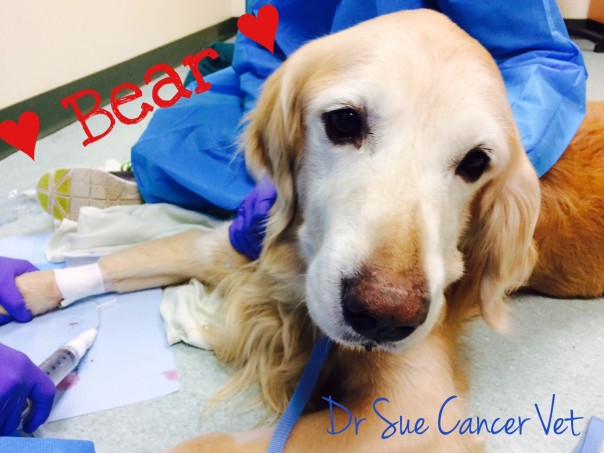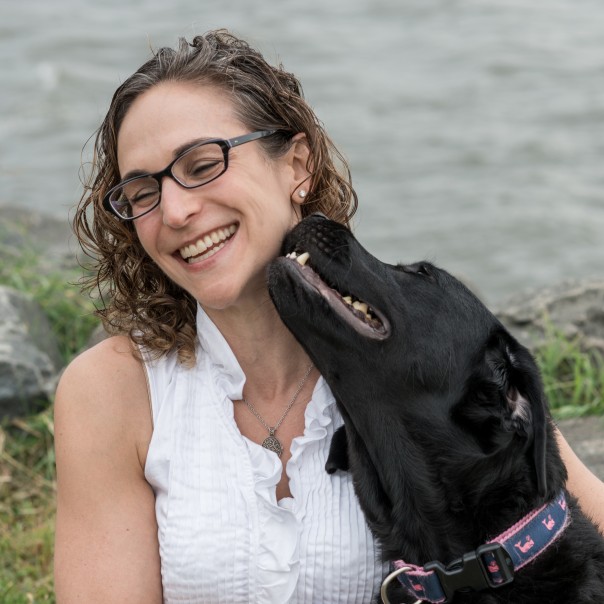
I messed up. I missed a tumor in my own veterinary technician’s dog. How did I let this happen? How did I fail Smokey and Amanda?
Smokey was my inspiration for a new cancer awareness program called See Something, Do Something. I am on a mission to help us all detect tumors earlier – whether you are a veterinarian, veterinary team member, or a pet owner.
At the time, Smokey was a 10-year-old white Pit Bull that belonged to one of my technicians, Amanda. I adored them both. Smokey was one of those amazing, soulful dogs that spread sunshine with every wag of his tail. Everyone who met Smokey loved him. He was Amanda’s once-in-a-lifetime-dog.
I had aspirated over 10 skin masses on Smokey over the years, and the masses had always been benign fatty lipomas. [An aspirate is when we poke things with a small needle and then look at the cells and fluid we get out under a microscope.]
When Amanda mentioned she was bringing Smokey in to check out a new mass a few weeks earlier, we all expected it to be the routine: a quick aspirate, fat on the microscope slides, give a treat to Smokey, collect some wags and kisses, and on his way.
The first day Amanda brought Smokey in, the clinic was so busy that we never got to Smokey’s aspirate. But none of us were worried because we assumed it was just another benign lipoma.
When Smokey returned the following week, I examined the 5 cm mass that was deeply attached to the underlying tissue on his left flank area. As I did my aspirate, I could see blood collecting in my needle and syringe. I immediately knew this was not a lipoma. I aspirated the mass in a few more areas, and we submitted the slides to the lab for cytology.
I told Amanda that my clinical hunch was a tumor. Tears welled up in her eyes.
As veterinary professionals, we deal with cancer in dogs and cats every day but nothing can prepare you when it is YOUR pet. I could see Amanda’s mind start to race and shut down at the same time. I gave her a huge hug, and we waited anxiously overnight for Smokey’s cytology results.
The cytology came back as a soft tissue sarcoma. Soft tissue sarcomas, or STS, are malignant
(cancerous) and develop in a variety of connective tissues. They can be found all over the body, from head to trunk to paws. The majority of these tumors are aggressive locally, which means they dig into the neighboring tissues. They are also prone to come back if they are not removed with wide margins.
The good news is that the low and intermediate grade versions of these tumors typically don’t metastasize, or spread. Low and intermediate grades of soft tissue sarcomas are very treatable. So surgery can be curative if the mass can be removed completely.
For Smokey, the next step was a biopsy to confirm the tumor type and help our soft tissue surgeon appropriately plan his surgery. I ran blood and urine tests, and ordered chest X-rays and an abdominal ultrasound to make sure the cancer hadn’t spread – all clear!
On surgery day, Smokey had a CT scan to get a better idea of the size of the tumor. These cancers are famous for having tentacle-like projections that can extend for centimeters away from the mass. If we leave the tumor tentacles, the tumor will likely regrow.
To avoid those tentacles, these tumors generally require 3-centimeter margins (more than an inch) around the tumor and a plane of tissue underneath the tumor. Smokey’s tumor thus required a really big surgery: for a 5-centimeter tumor, the incision should be at least 11 cm (or 4.3 inches).
Smokey’s surgery went well. He spent 2 days in our ICU recovering, and we anxiously waited for his biopsy report. The biopsy report confirmed GREAT NEWS: a low-grade (grade 1) hemangiopericytoma with wide, clean margins. He did not need more treatment – no post-operative radiation or chemotherapy. I just recommended regular monitoring of the scar and periodic chest X-rays.
Even though Smokey’s surgery had a happy ending, his malignant tumor really hit me hard. In hindsight, if we had aspirated this earlier when the mass was smaller, his surgery would have been simpler. How could I, a cancer specialist, have missed this tumor? And did I misguide Amanda?
Were there guidelines I had forgotten? I pulled out cancer books, journals, and cancer notes from my medical oncology residency. No, there are no guidelines for veterinarians or pet owners for when to aspirate or biopsy a mass on a dog or cat. The recommendations for doing an aspirate include generalities – “recommend if a mass is changing in size or appearance, or bothering the patient.“
Owners are often told to “keep an eye on it.” But what does that mean? Keep an eye on it for how long? How much can it grow before we should do something?
I hear all too often that a mass does not look or feel malignant. The pet owner should just monitor the mass and wait until it is bothering the pet. This is not good enough!
When tumors grow, what could have been removed with a simple surgery may now require a bigger surgery and radiation or chemotherapy afterwards. Even worse, the tumor may become too big to be removed or treated at all.
No one, not even a cancer specialist like me, can look at a mass and know what it is. We must do better. We must find tumors earlier when they are small. We must aspirate them. That’s where See Something, Do Something comes in.
See Something, Do Something:
See something – if your dog or cat has a mass that is the size of a pea (1 cm) and has been there 1 month,
Do something. Go to your vet and get it aspirated (or biopsied)
Do not get complacent like I did. Even after many benign aspirates, the next one can be malignant (like Smokey’s was).
See Something, Do Something. Why wait? Aspirate.
About Sue Ettinger, DVM, DACVIM (Oncology)
Dr Sue Cancer Vet
Dr. Sue Ettinger, ACVIM (Oncology), is a boarded veterinary medical cancer specialist. She attended Cornell University College of Veterinary Medicine. As a Diplomate of the American College of Veterinary Internal Medicine (Oncology), and she is 1 of approximately 300 board-certified veterinary specialists in medical oncology in North America. Dr. Ettinger is currently the head of the Oncology Department at the Animal Specialty Center in Yonkers NY.
Also known as Dr Sue Cancer Vet, she is a book author, radio co-host, and Certified Veterinary Journalist. Dr. Sue is the co-author of the Second Edition of The Dog Cancer Survival Guide, and she co-hosts The Pet Cancer Vet, an internet radio show on radiopetlady.com. From 2011 to 2014, Dr. Sue was a regular contributor to the blog, www.dogcancerblog.com. She lives in Westchester NY with her husband, a veterinary internist, their two sons, their goofy black Labrador, Matilda, and their dog-loving orange cat, Jeter.
Dr. Sue is passionate about raising cancer awareness, and she has developed See Something, Do SomethingTM to promote early cancer detection and diagnosis. The sooner we determine whether a mass is cancerous and should be removed, the better for our pets. Most skin and subcutaneous tumors can be cured if diagnosed early when masses are small. Early detection saves lives.
She can be found on social media at www.facebook.com/DrSueCancerVet and @DrSueCancerVet on Twitter.




